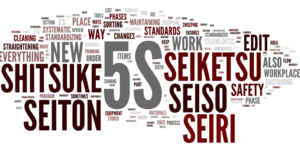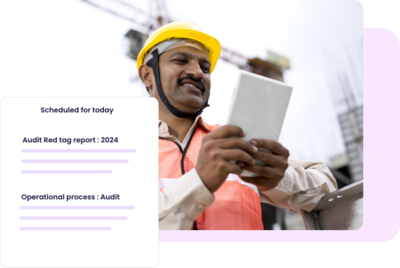he 5S methodology is a key part of lean manufacturing. It helps organize workplaces, reduce waste, and improve productivity. At the core of this system is the 5S Audit Checklist, which makes sure the five principles — Sort, Set in Order, Shine, Standardize, and Sustain — are followed consistently across the organization.
The checklist helps teams carry out regular audits, find areas for improvement, and maintain long-term success.
In this detailed guide, we will explore the components of the 5S Audit Checklist, how it can be used in different industries, and why the Dataspire 5S Audit Software can be an invaluable tool in automating and enhancing the audit process.
What is the 5S Audit Checklist?
The 5S Audit Checklist is a structured framework used to evaluate how well an organization adheres to the five core principles of 5S. This tool allows businesses to regularly assess their work environment, identify inefficiencies, and implement corrective actions to maintain high standards of productivity, safety and cleanliness.
Each of the 5S steps contributes to the overall efficiency and effectiveness of a workspace. The checklist serves as a reminder to implement and sustain these practices, ensuring that the principles of 5S become ingrained in daily operations.

The Components of the 5S Audit Checklist
Sort (Seiri): The first principle of 5S focuses on eliminating unnecessary items from the workspace. The goal is to retain only the tools, materials, and equipment that are needed for daily tasks. The checklist for this step would include questions like:
- Are unnecessary items removed from the workspace?
- Are tools and equipment clearly marked and stored in designated locations?
- Is there a process for disposing of unneeded items?
Sorting helps reduce clutter, making it easier for employees to find what they need quickly and improving overall efficiency.
Set in Order (Seiton): The second principle focuses on organizing the workspace for maximum efficiency. Tools, materials, and equipment should be arranged in a way that minimizes wasted time and effort. The checklist for this step may include:
- Are tools and equipment stored in a logical, accessible order?
- Are labels and signage clear, helping employees locate items quickly?
- Is there a designated space for everything, and is everything in its place?
This step is critical in ensuring that employees spend less time searching for materials and more time focused on value-added activities.
Shine (Seiso): The third step focuses on cleanliness. A clean workspace not only improves safety but also boosts employee morale. Regular cleaning schedules should be established and followed, and the audit checklist may include:
- Is the workspace clean and free of debris?
- Are cleaning responsibilities clearly assigned to employees?
- Is equipment regularly maintained to prevent malfunctions?
By keeping the workplace clean, businesses can reduce the risk of accidents and create a more pleasant working environment.
Standardize (Seiketsu): The fourth principle emphasizes the need to establish standards for implementing and maintaining the first three steps. Standardizing ensures that the benefits of 5S are sustained over time. The checklist for this step might include:
- Are there written standards for organizing, cleaning, and maintaining the workspace?
- Are employees trained in 5S practices and aware of their responsibilities?
- Are audits conducted regularly to ensure compliance with 5S principles?
Standardization makes it easier to maintain a high level of performance and ensures that employees follow best practices consistently.
Sustain (Shitsuke): The final step of 5S focuses on sustaining the improvements made. The goal is to make 5S part of the company’s culture. The checklist for this step might include:
- Are employees regularly reminded of 5S principles through training or signage?
- Are successes and improvements recognized and rewarded?
- Is there a system in place for continuous improvement and feedback?
Sustaining 5S ensures that the organization remains committed to maintaining a clean, organized, and efficient workspace.
The Importance of Regular 5S Audits
Regular audits are essential for ensuring the continued success of 5S implementation. Without regular reviews, it’s easy for standards to slip, leading to inefficiencies, clutter, and safety hazards. The 5S Audit Checklist provides a structured approach to evaluating the workplace, making it easier to identify areas where improvements are needed.
The benefits of regular 5S audits include
Improved Efficiency: By regularly reviewing the workspace, organizations can identify and address inefficiencies that may arise over time.
Enhanced Employee Engagement: When employees see that the organization is committed to maintaining a high standard of workplace organization and cleanliness, they are more likely to take ownership of the process.
Increased Safety: A clean and organized workspace reduces the risk of accidents and injuries.
Sustained Continuous Improvement: Regular audits help keep the focus on continuous improvement, ensuring that the organization remains committed to the 5S principles.
How the Dataspire 5S Audit Software Enhances the 5S Audit Process
While manual audits using paper checklists can be effective, they are often time-consuming and prone to human error. The Dataspire 5S Audit Software offers a digital solution that simplifies the audit process, making it more efficient, accurate and reliable.
Key Benefits of the Dataspire 5S Audit Software
Automated Checklists: Create custom checklists tailored to your specific needs and automatically distribute them to the relevant teams.
Instant Notifications: Receive notifications for non-compliance or areas that require immediate attention, ensuring that corrective actions are taken promptly.
Collaboration Tools: Share audit results with team members and management to ensure everyone is aligned and working towards the same goals.
5S System
Real-Time Data Collection: The software allows for real-time data tracking, enabling you to monitor 5S compliance instantly and address issues as they arise.
Data Visualization: The software provides visual representations of audit data, making it easy to analyze trends and identify areas for improvement.
Scheduled Audits: Plan and schedule audits in advance to ensure that 5S principles are consistently followed across all departments.
Implementing the 5S Audit Checklist in Different Industries
Although the 5S methodology is often associated with manufacturing, it can be applied across a variety of industries. The core principles of 5S organization, cleanliness, and efficiency are relevant in any work environment. Heres how the 5S Audit Checklist can be implemented in different industries:
Manufacturing: In a manufacturing setting, the 5S Audit Checklist ensures that tools, materials, and equipment are organized and easily accessible, reducing downtime and improving productivity.
Healthcare: In healthcare environments, the 5S Audit Checklist can be used to organize medical supplies, ensure cleanliness in patient care areas, and improve overall efficiency.
Retail: In retail, the 5S Audit Checklist helps maintain organized stockrooms and clean sales floors, ensuring that products are easily accessible to customers and employees alike.
Office Environments: Even in an office setting, the 5S Audit Checklist can help organize files, reduce clutter, and create a more productive work environment.
Conclusion
Why the 5S Audit Checklist is Essential for Success
The 5S Audit Checklist is more than just a tool for maintaining a clean and organized workspace; it is a driver of continuous improvement and operational excellence. By regularly auditing your workspace, you can ensure that 5S principles are consistently applied, leading to increased efficiency, safety, and employee engagement.
Embrace the power of the 5S Audit Checklist and elevate your organization’s performance to new heights! Try Now !

